





Puya is a little known bromeliad from South and Central America that grow as an unassuming but thorny twisted leaf mass, but also some of the most spectacular plants in the plant kingdom. The following article is an introduction to some of the more impressive as well as common species of Puyas grown in cultivation.
Most growers probably do not know what a Puya is... nor will they ever care (unless they read this article). These are somewhat frost tolerant, heat-loving, drought tolerant terrestrial Central and South American bromeliads that love the arid sun and are really not well suited to most landscapes across the US. For the most part, the plants themselves are somewhat less than ornamental. So why grow them? Once one sees their flowers, maybe one will see why. The following is a brief overview of some of the more commonly grown and spectacular species of Puya, as well as a few less impressive but more common species one can find in cultivation.
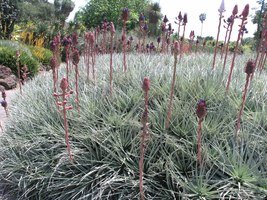 Puya venusta colony in Huntington Gardens, California
Puya venusta colony in Huntington Gardens, California
The genus Puya supposedly contains over 100 species, most native to the higher elevations in South America. Despite the large number of species in the wild, only a dozen or so are ever seen in cultivation and only a few are ‘common'. These are bromeliads, and like most bromeliads, these plants are primarily monocarpic (die once they finish flowering). However, these are generally prolific growers and the death of a single flowering individual in a large colony of Puyas rarely is a noticeable event. I am not convinced that even most cultivated Puyas are monocarpic as I rarely see the corpses of flowered rosettes despite my looking hard for them. But I could see how I could miss them as one can hardly traipse out into the colony easily as most species are less than ‘user-friendly', being heavily armed with extremely sharp marginal leaf barbs. It seems most other terrestrial arid-loving bromeliads like Hechtias, Dyckias and Bromelia species are similarly armed. This fact, along with their somewhat dull leaf color and monotonous densely packed colonies make these less than optimal landscape species for all but the quirky or curious landscapers with lots of room on their hands. Their spectacular flowers are definitely jaw-dropping in many species, but the flowering season is a short one (usually in the spring) and then one is left with a large, often ugly, messy and very unfriendly mass of dull grey-green plants. Some species are ornamentally whitish and striking (some forms of Puya alpestris for example) but most are not.
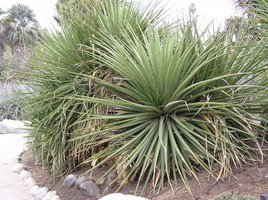 Puya chilensis showing barbs on leaves
Puya chilensis showing barbs on leaves
Puyas are very drought tolerant plants requiring little water after flowering season and can go many months in arid, intense heat with no extra water (not all Puyas are like this), making many growers and collectors include them in the succulent group. However, I do not think these plants qualify as succulents despite their overall similarity to Agaves.
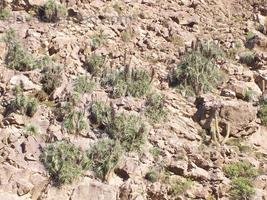 Puya berteronianas in native Andes mountains (photo by Ursula)
Puya berteronianas in native Andes mountains (photo by Ursula)
For more pictures of Puyas, visit the Bromeliad photo index (and awesome and extremely useful website for any Bromeliad lover): http://www.fcbs.org/pictures.htm
Most of what I have learned about Puyas is based upon observations of the colonies in the Huntington Gardens near Pasadena, California, and from what little information I have gleaned on line as well as my own limited experiences growing these plants.
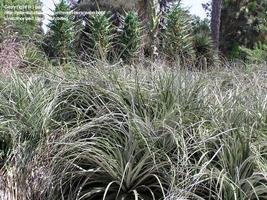 Puya alpestris in Huntington Gardens
Puya alpestris in Huntington Gardens
Puya alpestris (aka the Sapphire Tower) is one of the more commonly grown Puyas and one of the few one might encounter in a private garden. This is a variable species with some forms having nearly white leaves- striking landscape plants indeed. The leaves are curled, barbed and flexible. These are very drought tolerant plants but seem to respond to water. It is a slow growing plant but fortunately does not need to attain a huge size or colony before rewarding one with a flower. The inflorescences grow up to 4' tall and are covered with deep blue-green to nearly blackish-blue-green flowers that are so brilliant one can hardly believe they are not some plastic creation.
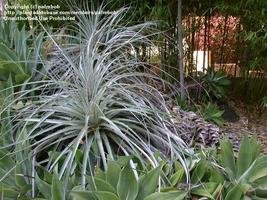
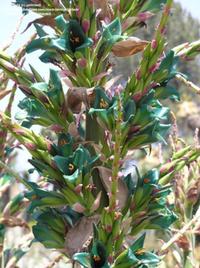
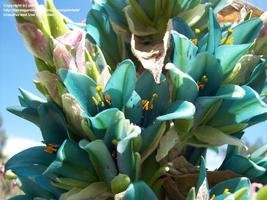
Puya alpestris plant inflorescence individual flowers- amazing color!
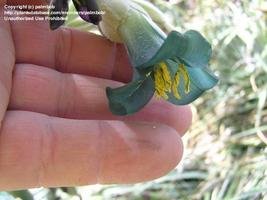
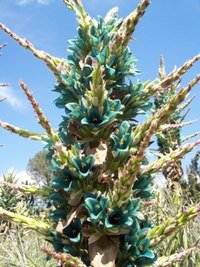 more shots of Puya alpestris
more shots of Puya alpestris
Puya assergens is a smaller plant from Argentina, only 12"-18" tall and has grass-like leaves... in fact, clumps of this look a lot like grass. It is certainly not a very ornamental plant, but it still produces some of the nicer flowers for a small Puya. The flowers are cord-like and bright coral red with deep bluish green throats. At least this one takes up little room and would be an interesting plant for the garden in late spring when it flowers.
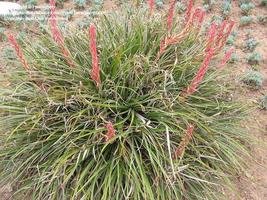
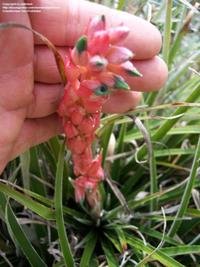 Puya assurgens in Huntington Gardens
Puya assurgens in Huntington Gardens
Puya berteroniana (the Blue Puya) is a much larger and even more dangerous plant, rarely grown outside its native habitat in the Andes except for in a few botanical gardens. This plant looks different from Puya alpestris in its overall size and color, but the flowers are quite similar- perhaps even a darker huge of unbelievable turquoise-blue. I personally cannot tell the flowers from those of Puya alpestris, at least based up photos on the web or flowers at the Huntington Gardens.
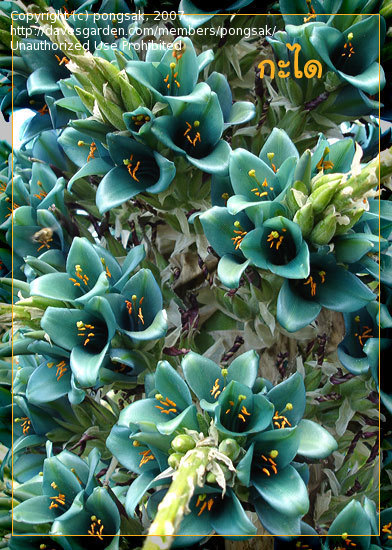
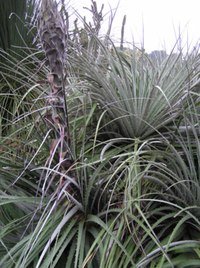
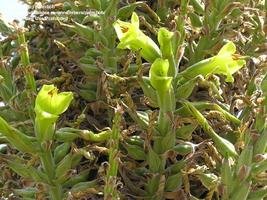
Puya berteroniana (photo by bert pongsak) Puya berteroniana shots from the Huntington Gardens, California
Puya chilensis is a larger, slow growing plant that forms huge, impenetrable colonies along the hillsides of parts of Chile. This plant has pale greenish leaves that are lined with large, sharp barbs. Plants grow up to 4' tall. This is not a good plant for most gardens, but it is quite slow growing so perhaps could be managed. It has some frost tolerance and is very drought and sun tolerant. Plants do not flower, however, until several decades old, though the wait may be worth it as they make some of the most spectacular flowers of all the Puyas. They are up to 6'-7' tall and look like medieval weapons with flower spikes sticking out in all directions. The flowers themselves are as chartreuse as any in the plant kingdom and look unreal.
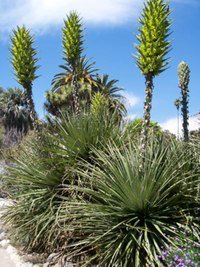

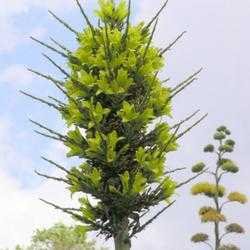
Puya chilensis in the Huntington
Puya coerulea (aka Aqua Sapphire Tower) is a medium sized Puya from Chile that looks somewhat like many other species (eg. P alpestris or venusta) having pale grey-green leaves and forming large, impenetrable colonies of barbed foliage. The leaves of this species are fairly straight with only a bit of recurving or twisting near the tips. The flowers are quite unique, however, being about 4'-5' tall on brilliant red stalks and branches with nearly black-blue to violet flowers erupting from the crimson bracts. The stamens and pistils add to the brilliance with bright gold and lime green. There are two forms of this plant with the Santiago form being the more impressive and larger plant. The other form, sometimes referred to as variety violacea, is a much smaller plant, only 8"-12" tall and has relatively sparse inflorescences, still colorful, but far less impressive.
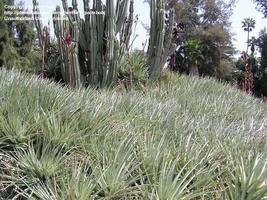
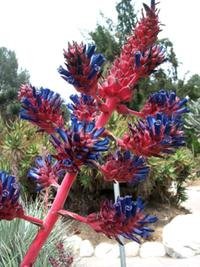
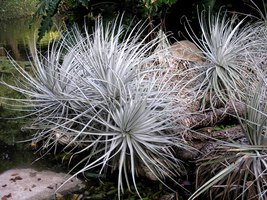
Puya coerula colony at Huntington (looks just like Puya venusta in this regard). Puya coerula flower larger type; Puya coerula variety (possible violacea) showing nice white coloration
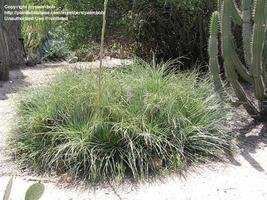
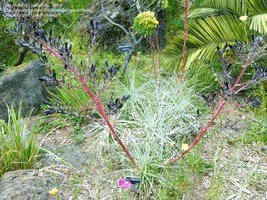
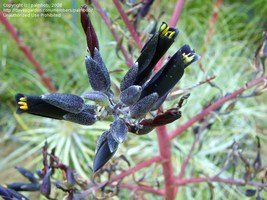
what is labeled as Puya coerula var. violacea in Huntington Gardens, and other two showing plant up in northern California
Puya mirabilis is a dwarf Puya usually 1' tall at the most and has only the smallest barbs (but can still stick you if you're not careful). This Bolivian species flowers in the fall and has very tall inflorescences relative to the size of the plant (up to 5' tall) with dull grey-blue bracts that hold the pale chartreuse flowers. This one makes a good potted plant even and can be bonsaid. However, the plant is not terribly ornamental most of the year and just looks like a tuft of grey-green stiff grass.
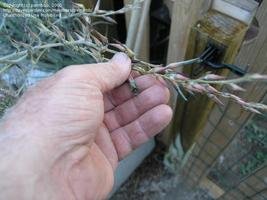
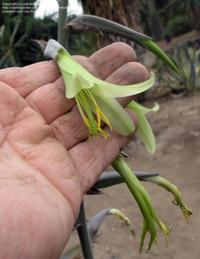 Puya mirabilis and flower
Puya mirabilis and flower
Puya laxa is one of the more commonly grown Puyas and one can often find this at nurseries that sell cactus and succulents. It is one of the more attractive species without flowers having fuzzy grey twisted leaves. I definitely recommend this one for pot culture as planted in the garden it grows aggressively taking over larger areas in no time (use thick leather gloves to prune this one back!). The petite flowers themselves are an interesting and attractive dark blue-green arising in a tubular shape from fuzzy pale red bracts... but the entire branched inflorescence is less than appealing and messy and spindly looking. I have this one in my garden now and I find it a repugnant plant at least in terms of having to prune it or do anything near it. Its apparent fuzziness is misleading, I warn you!
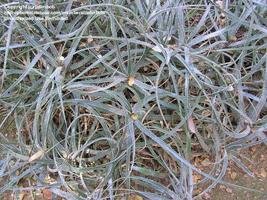

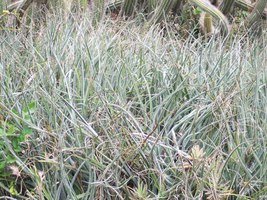
Puya laxa in private garden; my one plant flowering 'mess' in botanical gardens
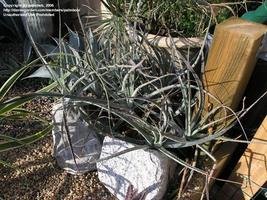
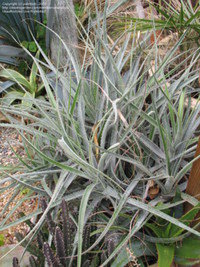
plant in my garden initially, and a year later (rocks buring, as are all nearby plants)
Puya raimondii is the largest of the Puyas and a spectacular plant. It is famous for having the largest flowers of all the bromeliad species. This solitary plant is really too big to grow in most gardens, but a great plant for botanical gardens. I unfortunately have never seen this species in person so do not have a photo of it, but you can visit the Bromeliad Photo Index at this web site and see this species in habitat (along with many other Puya photos): http://fcbs.org/cgi-bin/dbman/db.cgi?db=photo&uid=default&photono=1365&ww=on&mh=5&view_records=View+Records
Puya spathacea is an Argentinian species that, like most Puyas, is not too impressive most of the year. It has the typical grey-green barbed leaves and grows in a tight colony of plants up to 4' tall. Inflorescences are branched with perpendicular branches fairly well spread out in different directions along the stalk. The entire inflorescence is pale pink to brilliant red, though the flowers themselves are dark blue-violet-black.
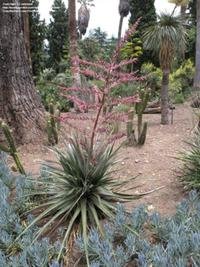
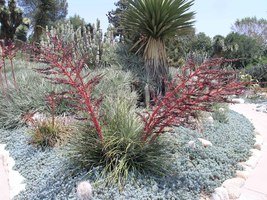
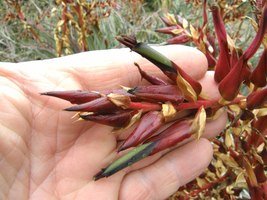
Puya spatheceas in Huntington Gardens
Puya venusta is another Chilean Puya with grey-silver leaves and spectacular flowers in spring. The pink infloresecences of this plant are about 3' tall, branched with each branch end and top terminating with a spherical mass of deep blue to black-violet flowers erupting from pinkish to red fuzzy bracts. Peeking out from the tubular dark blue flowers are brilliant yellow-green stamens.
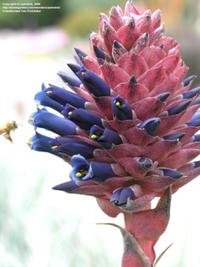
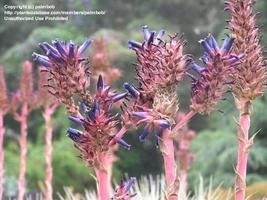
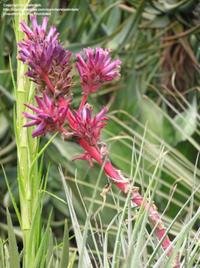
Puya venusta flowers in Huntington Gardens
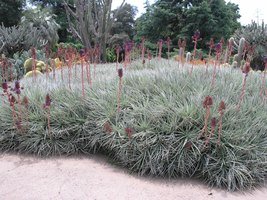
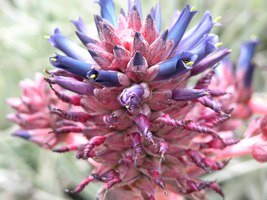 more Puya venusta shots
more Puya venusta shots
There are scores of other Puyas and a few can be found in botanical gardens through the southern US, most these are the ones I find the most common or spectacular. If you have a large yard in the right climate and don't mind a large, painfully sharp shrub in a sunny, drier spot, maybe some of these would be the right plants for you.
Copyright © www.100flowers.win Botanic Garden All Rights Reserved